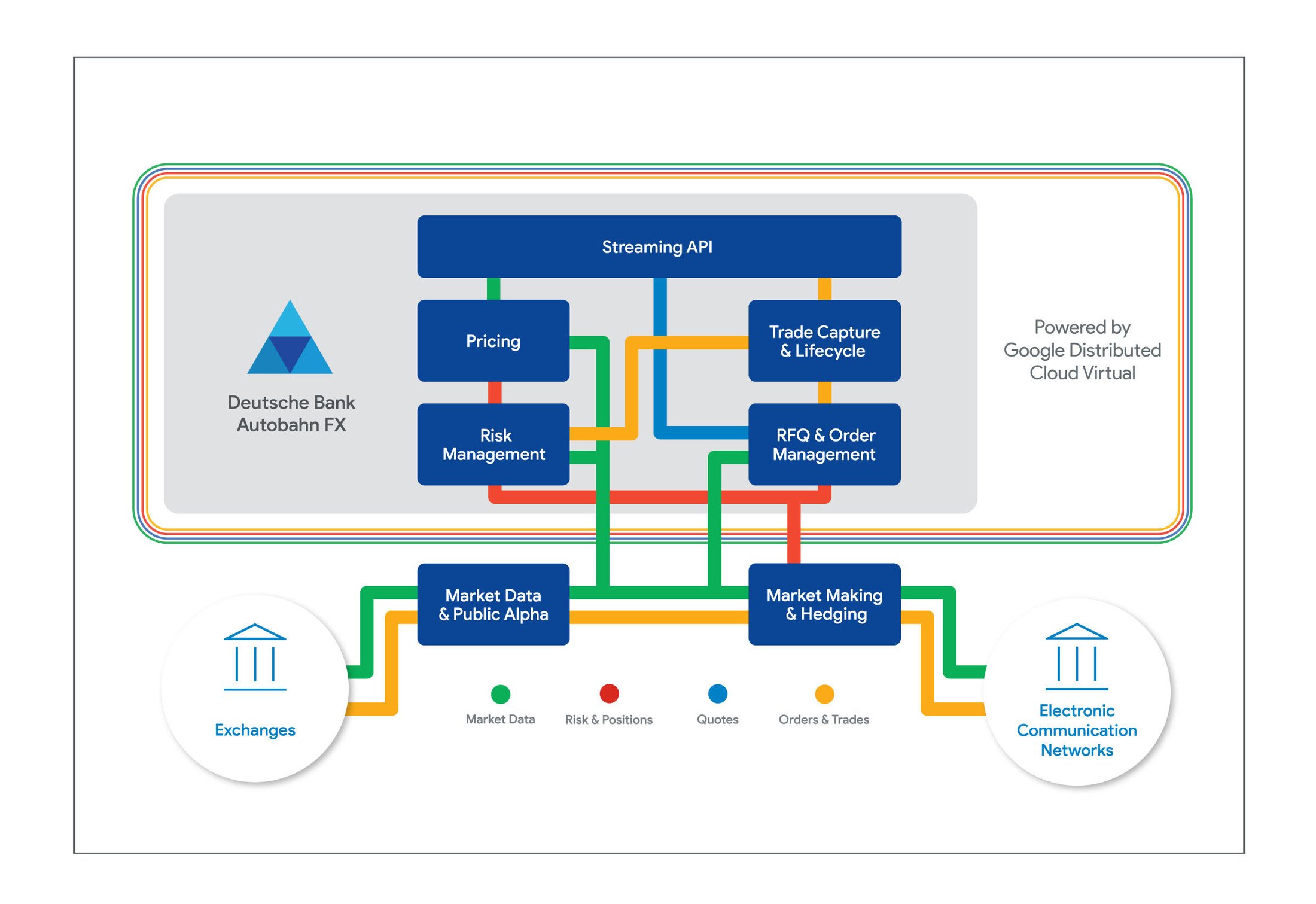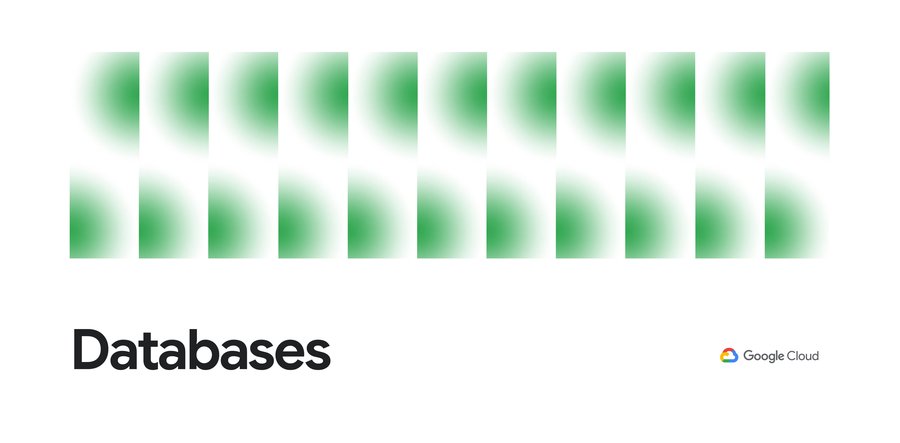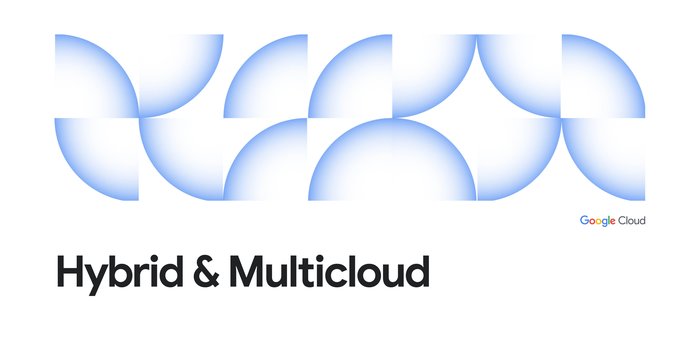How Deutsche Bank uses Google Distributed Cloud for its Autobahn FX real-time trading platform
Pavel Malyarevsky
Engineering Owner of the FIC Hybrid Platform, Deutsche Bank
Yuriy Babenko
Customer Engineer, FSI
A modern electronic trading system is a sophisticated, global, scalable application which needs to process high transaction volumes every fraction of a second. Deutsche Bank Autobahn FX is one of the leading electronic trading platforms for foreign exchange and precious metals, serving institutional and corporate clients worldwide.
Traditionally, electronic trading applications have avoided adopting cloud technologies due to stringent requirements on the latency and global distribution of these types of services. Google Cloud compute offerings are not limited to public cloud regions providing a set of options that allow customers to operate Google’s tested and validated software on top of their own infrastructure.
Deutsche Bank and Google Cloud have been effectively collaborating and partnering on various use cases in retail banking using Google Cloud’s public regions. In this post, we’ll share more details on expanding this partnership to foreign exchange and precious metals trading, utilizing the benefits of a distributed hybrid infrastructure.
Demands of a modern electronic trading system
Autobahn FX is Deutsche Bank’s primary trading platform. It brings together clients (e.g., investment funds, corporations, other banks) and venues (e.g., exchanges, electronic communication networks), helping them to transact on different asset classes. The platform offers a robust infrastructure for trade execution, specializing in foreign exchange currencies, such as the Euro, Dollar, and Yen, and precious metals like gold and silver.
Trading systems thrive on data. To ensure smooth operations, it is essential to set up the following core data flows:
-
Client orders: Input data to provide the system with trading directives
-
Market data: Real-time market data feeds reflecting live market conditions
-
History: Historical records of completed trades and activity
-
Real-time analytics: risk values that quantify potential exposure and inform decision-making
These dataflows must be carefully optimized for low latency to achieve the necessary speed and volume of transactions. Unpredictable spikes in transactions often pose a scalability challenge, requiring the need to adopt a distributed system architecture. According to a diverse web of global regulatory rules, this infrastructure requires a model that can run inside a specific geographic location. Google Distributed Cloud Virtual (GDCV) for Bare Metal allows Deutsche Bank to leverage a hybrid cloud architecture, spanning data center locations operated by the bank as well as Google Cloud regions.
GDCV utilizes Google Kubernetes Engine (GKE), a scalable, fully managed Kubernetes platform, which allows Deutsche Bank to efficiently use the bank's underlying data center infrastructure. On-premises deployment is combined with workload mobility, elasticity and enhanced services available in Google Cloud regions, provided by GKE Enterprise, a fully integrated platform for governing, managing, and operating containerized workloads at enterprise scale.
GDCV as a modernization platform
Autobahn FX is built around three main components, which Deutsche Bank has effectively reengineered: customer-facing components, a core application, and market connectivity.


Customer-facing components
Deutsche Bank runs a set of streaming API endpoints to serve key customer-facing channels, including the FIX and REST-based API, a web application, and a mobile application. These APIs compose the client-facing part of the Autobahn FX platform and act as a centralized gateway to ensure and protect all communications between the application and clients. The platform also implements a miniservices architecture powered by GDCV on Bare Metal instead of a microservices architecture due to challenging non-functional requirements where interconnections can impact signal latency.
The key objective of the service is to provide the necessary liquidity to customers with the minimum latency and at the best price possible.To achieve that, the bank selected GDCV for Bare Metal, providing direct access to the underlying performant server hardware. The networking stack incorporates a combination of the following components:
-
Bundled MetalLB: A highly available Layer 4 load balancer tightly integrated with GKE on Bare Metal
-
Ingress: A custom Layer 7 load balancer built on Nginx and Java plugins instead of a bundled ingress component on top of Envoy
-
Multi-nic: An additional network interface for multicast traffic in Pods
Core application architecture
The bulk of Autobahn FX’s architecture runs as a set of multiple Java miniservices. In this architecture, the system is divided into a number of independent services responsible for a specific business task, allowing Deutsche Bank to easily scale, maintain, and update the system.
Market connectivity
Deutsche Bank leverages multicast to transport data feeds at low latency. Markets have to provide market data in an extremely fast way, but additionally, there is an important requirement to be fair. It is very hard to achieve fairness with point-to-point connectivity if one of the market data consumers receives the data earlier than another. Multicast technology is used to resolve this. Typically, multicast is served on a dedicated network interface for performance reasons. To address this efficiently, Deutsche Bank used the multi-NIC feature of GDCV, backed up by Multus CNI. As a result, each Kubernetes pod that requires access to multicast connectivity can obtain a second network interface with specific routing rules.
Containerization on bare metal infrastructure is the Autobahn FX future
In the fast-paced world of financial trading, traditional on-premises, non-containerized environments struggle to keep up with the demands of modern workloads. Some of the key challenges include:
-
Inefficient resource utilization: Classic trading systems can lead to underutilized hardware, resulting in wasted resources and higher costs.
-
Lack of standardization in the hardware footprint: Heterogeneous hardware landscapes make it difficult to manage and upgrade systems, hindering agility.
-
Scalability constraints: Scaling infrastructure to meet dynamic market demands can be complex in non-containerized environments.
While public cloud services offer attractive benefits, they may not always be suitable for trading applications due to regulatory restrictions or the need for physical proximity to trading venues to minimize latency.
The hybrid cloud architecture built on top of GDCV for Bare Metal and GKE Enterprise allows Deutsche Bank to address these challenges, while offering a unified platform for the Autobahn FX application. With open-source Kubernetes as a base, GKE on Bare Metal enables efficient standardization of the application design and the ability to optimize the local hardware footprint of collocations.
Here’s how Deutsche Bank uses this architecture to power the Autobahn FX platform:
-
The GDCV components that run the bank’s collocations are deployed to major financial hubs with physical proximity to the trading venues and clients. These components, which run on the bank's own hardware, can be scaled up fast as additional deployments are needed across the globe using well-defined and standardized architecture.
-
The GKE components run in the Google Cloud Public regions are used to deploy auxiliary and non-latency critical parts of the Autobahn FX platform, such as CI/CD and observability tools for on-prem infrastructure.
-
GKE Enterprise provides an integrated container platform incorporating fleet-wide team management, configuration and policy management, security posture and observability — across all deployed components both on-premises and in Google Cloud regions.
“Deutsche Bank can now roll out a new FX application environment in just one hour, instead of two weeks. The dramatic reduction in deployment time arises from strategic implementation of containerization and environment standardization. By leveraging GKE on Bare Metal, we've built a streamlined approach which allows for fast, automated deployment, ensuring exceptional environment elasticity and better hardware utilization. This transformation has led to a remarkable reduction in server count, driving costs reduction by 25%.” - Maximilian Novikov, Head of Autobahn FX Platform Engineering, Deutsche Bank
Through its strong partnership with Google Cloud to power this new hybrid cloud architecture, Deutsche Bank's engineering team has taken a giant leap forward in electronic trading infrastructure. This breakthrough rests on using Google Distributed Cloud Virtual and GKE Enterprise to provide the reliability and performance demanded by the bank's critical trading applications. As a result of this engineering cooperation, these services can now provide reliable support for multicast and latency comparable to Bare Metal servers, improving workload density by up to 70%. In the future, Deutsche Bank is looking forward to expanding its footprint and usage of this flexible infrastructure.
We want to thank Maximilian Novikov and Valentin Hamburger for their contribution to this article.


